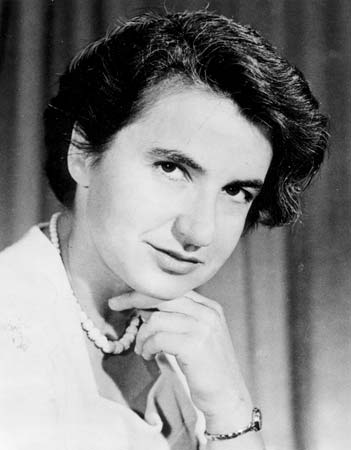
Today’s Google doodle for Rosalind Franklin has a lot of people asking, “Rosalind Who?”
In honor of the Rosalind Franklin doodle, we’re glad to hereby repost our 2008 primer on the Franklin controversy, written after DNA hero James Watson had made a few snide remarks about her. Which, as we’ll see, he tends to do.
Kudos to Google for giving Franklin a boost today. Enjoy the story.
* * *
DNA discoverer and Nobel Prize winner James Watson has ruffled feathers yet again with new comments about his fellow scientist Rosalind Franklin — the woman who took a crucial X-ray image that helped him make his big discovery.
Watson told the Guardian that he thinks Rosalind Franklin was “partially autistic” and “either not a nice person, or just clueless.”
Well, here we go again. The brouhaha between Watson, his late partner Francis Crick, and the supporters of Rosalind Franklin is one of the great intramural wrassling matches of 20th-century science. It’s a convoluted tale of scientific egos, office politics, latter-day feminism, and DNA knows what else.
Watson and Crick were the first to detail the double-helix structure of DNA, in 1953, and the discovery brought them everlasting fame and glory. It also won them the 1962 Nobel Prize along with a collaborator, Maurice Wilkins. That’s where Rosalind Franklin comes in: she was an X-ray crystallographer who worked with Wilkins early in the 1950s, and she took the difficult and precise photo of a DNA molecule (called “photo 51”) that was a crucial piece of evidence in helping Watson and Crick make their final discovery.
Here’s the catch: Franklin and Wilkens didn’t get along too well, and it seems that he showed Watson and Crick the vital Franklin DNA photo without her permission or knowledge.
 Rosalind Franklin in an undated photo
Rosalind Franklin in an undated photo
Rosalind Franklin died of cancer in 1958, and she apparently went to her grave without knowing that Watson and Crick had ever even seen the photo. By 1962, Franklin was not eligible for the Nobel Prize (you must be living to be receive a Nobel — who knew?), though it’s far from clear that she would have been included anyway.
Before Watson and Crick made their big breakthrough, a whole lot of people were hot on the trail of the truth about DNA, including Franklin herself. (Even the venerable Linus Pauling was in the mix.) So that little peek that Wilkins gave to Watson and Crick was quite a breach of etiquette, to say the very least.
Still, it all might have ended there. But then Watson kick-started a controversy with his 1968 memoir, Double Helix, in which he gave short shrift to Franklin, more or less suggesting that she was less of a scientist and more of an irritable technician who would have got along better with men if she’d only prettied herself up a little. That sparked a backlash, particularly among feminists, some of whom came to believe that Franklin really originated the double-helix idea and Watson and Crick flat-out stole it.
As you drill down into the story there’s the weird clash-of-personalities subplot about Franklin’s lab at King’s College, because when Franklin arrived (in 1951) she was apparently told she was going to be her own boss with her own assistants, but meanwhile Wilkins was told she’d be working for him. They got off on the wrong foot and never quite got back on the right one, a state of affairs which may or may not mean anything at all.
For icing on the cake: As they all were hot on the trail of different possible structures in 1952, Franklin tweaked Wilkins when one of his theories was proved wrong by passing out cards around the lab announcing a “funeral” for the helix model of DNA. Which means she didn’t believe it was a helix! And Watson and Crick owe her nothing! Or maybe she was just joking! Or maybe she rejected the single helix, but not the double! There seems to be an endless body of analysis of just this one tiny point.
Brenda Maddox, in her 2002 biography The Dark Lady of DNA, called Franklin “the Sylvia Plath of molecular biology.” That seems about right: depending on your point of view, Franklin is as much a genius or victim as you want her to be, as prickly or not as you want her to be, and (especially) as much a sacrificial lamb to Bad Male Ambition as you want her to be. Franklin was certainly no shrinking violet, and Maddox feels the Sylvia Plath angle is no big help to finding the truth about her.
In any case, Franklin didn’t get many props at the 1962 Nobel Prize ceremonies. Watson and Crick mentioned her not at all in their Nobel lectures. (Though to be fair, each mentioned Maurice Wilkins himself only once.) Wilkins gave her a bit more credit; he mentioned her among two dozen others in his final acknowledgments, thanking “my late colleague Rosalind Franklin who, with great ability and experience of X-ray diffraction, so much helped the initial investigations on DNA.”
Armchair psychologists might see James Watson’s continued ungenerous comments about Franklin as an indication that he still feels a wee bit guilty or insecure about her role in his great discovery. He’s got the Nobel and the fame, after all; it wouldn’t kill him to say a few kind words.
Or maybe he just wants to be outrageous. “Rosalind is my cross,” he tells journalist John Crace. Crace comments that “It’s not always easy… to work out which bits [Watson] really means and what he’s just saying because he’s on a roll and enjoying being provocative.” Or maybe a little of both.
For those looking for a primer on the whole crazy controversy, The New Yorker’s 2002 review of Maddox’s book tells the basic story quite well.
For more, see our full Rosalind Franklin biography »
